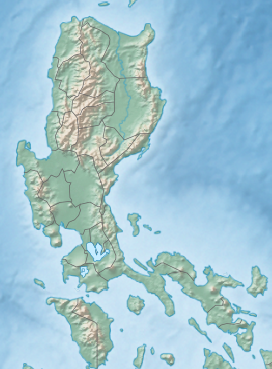Mount Masaraga
| Mount Masaraga | |
|---|---|
 | |
| Highest point | |
| Elevation | 1,328[1] m (4,357 ft) |
| Prominence | 1,003 m (3,291 ft)[2] |
| Listing | Inactive volcano[3] Ribu[4] |
| Coordinates | 13°19′N 123°36′E / 13.32°N 123.60°E |
| Geography | |
 | |
| Country | Philippines |
| Region | Bicol Region |
| Province | Albay |
| City/municipality | Ligao |
| Geology | |
| Mountain type | stratovolcano[1] |
| Volcanic arc/belt | Bicol Volcanic Chain |
| Last eruption | Unknown[1] / Holocene |
Mount Masaraga is a stratovolcano located in Ligao City in the province of Albay, in the Bicol region, on Luzon Island, in the Philippines.
Physical features
[edit]Mount Masaraga is a forested, sharp-topped, mountain with an elevation of 1,328 metres (4,357 ft) asl.[1] It is adjacent and the closest to the perfect cone of Mayon Volcano.
Eruptions
[edit]There are no historical eruptions from the volcano with the last eruptive activity dated as Holocene as reported by the Global Volcanism Program. Thick lava flows from that period are present on the flanks of Mount Masaraga, an understudied volcano in the Philippines.[1]
Geology
[edit]Rock type found on the mountain is andesite trending to rhyolite.[1] Tectonically, Masaraga is part of the Bicol Volcanic Chain of volcanoes and part of the Pacific ring of fire.
Listings
[edit]The Philippine Institute of Volcanology and Seismology (PHIVOLCS) lists the mountain as one of the inactive volcanoes of the Philippines.[3]
See also
[edit]References
[edit]- ^ a b c d e f "Masaraga". Global Volcanism Program. Smithsonian Institution. Retrieved 10 April 2019.
- ^ "World Ribus - Philippines". World Ribus. Retrieved 2024-12-22.
- ^ a b "Inactive Volcanoes Part 5". Philippine Institute of Volcanology and Seismology. Archived from the original on 12 February 2012. Retrieved 10 April 2019.
- ^ "World Ribus - Philippines". World Ribus. Retrieved 2024-12-22.



